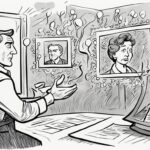Question Deflection. Question Avoidance. Rhetorical Question. Socratic Method. These terms evoke a world of intriguing conversational tactics, where words bounce and answers elude. I invite you to explore the art of answering a question with a question, where the spoken rhythm dances between curiosity and evasion.
Within the realm of communication, answering a question with a question is embraced in various contexts. Whether it is to redirect the conversation’s course, sidestep a direct response, or employ the wisdom of Socrates himself, this enigmatic technique plays a role in debates, discussions, and everyday encounters.
Imagine a delicate interplay of words, where one query begets another, invoking a captivating dance of thought. In this article, we dive deep into the meanings behind question deflection, its terms, and the psychological impact it can wield. So join me on this linguistic expedition as we unravel the captivating mysteries of answering a question with a question.
Terms for Answering a Question With a Question
When engaging in a conversation and employing the art of question deflection, various terms can aptly describe this rhetorical phenomenon. One such term is the counterquestion, which signifies the act of responding to a question with another question. This clever tactic serves to deflect the initial query while maintaining the conversational flow.
Deflection, on the other hand, is an evasion technique employed when a question is met with another question. By steering the conversation towards a different topic or aspect, the respondent skillfully avoids directly addressing the initial query. It is a subtle dance of words, where the true intent remains veiled behind layers of inquiry.
In a more sarcastic vein, rhetorical questions come into play. These questions are posed not with the expectation of a direct answer but rather as a persuasive tool, designed to make a point or underscore the absurdity of the original question. Rhetorical questions serve as powerful rhetorical devices, challenging the listener’s assumptions and prompting introspection.
“Why should I answer a question so laden with ignorance? Isn’t it better to ponder upon the wisdom of our existence?”
Furthermore, the art of question deflection can also be characterized by terms such as obfuscation, evasion, and diversion. These terms encapsulate the elusive nature of answering a question with a question, where the respondent carefully maneuvers the conversation away from direct answers. It is a dance of words, a skillful display of wit and intellect.
The Art of Question Deflection
In the art of communication, answering a question with a question can be a powerful tool. It serves various purposes and encompasses the uses of counterquestions, which have psychological impacts on both the questioner and the responder.
Counterquestions have the ability to gather more information about the initial question or create clarity. They help navigate complex discussions and guide the flow of conversation. For example, when engaging in a discourse about a particular study, asking a counterquestion to clarify which study is being referred to can eliminate any confusion.
However, counterquestions can also be employed as a deflection strategy to avoid answering uncomfortable or unwanted questions. Imagine being asked a deeply personal question that you’d rather not answer. Instead of directly responding, you could reflexively counter with another question, diverting the focus away from the original inquiry.
“Are you really asking if I’m seeing someone else, or are you trying to accuse me without evidence?”
Deflection, in the form of question avoidance, allows individuals to redirect blame, maintain their self-image, or protect their privacy. It becomes a defensive mechanism against perceived attacks or interrogations, providing a shield of emotional protection.
The psychological impact of question deflection is multifaceted. It can create a sense of control for the responder, allowing them to dictate the direction of the conversation. It also adds an element of intrigue and mystery, provoking curiosity in the questioner. Furthermore, question deflection can challenge preconceived notions, encouraging critical thinking and deeper engagement.
| Benefits of Question Deflection | Uses of Counterquestion | Psychological Impact of Deflection |
|---|---|---|
| Enhances conversational agility | Gathering additional information | Provides a sense of control |
| Redirects attention from sensitive topics | Creating clarity in complex discussions | Provokes curiosity and critical thinking |
| Maintains privacy and self-image | Avoiding uncomfortable questions | Challenges preconceived notions |
Question deflection in communication is an art. It requires finesse, strategic thinking, and careful consideration of context. Whether used to guide a conversation, protect oneself, or spark intellectual curiosity, it holds a unique place in the intricate tapestry of human interaction.
Using Counterquestions as Enriching Tools
Counterquestions, when used thoughtfully, can enrich a conversation and deepen understanding. By engaging in a respectful and open-minded exchange of counterquestions, individuals can navigate complex topics, challenge assumptions, and uncover new insights. Counterquestions open the door to exploration, growth, and mutual discovery.
Implementing Call Deflection Strategies
Call deflection is a powerful technique used by businesses to reduce the number of inbound calls that require human service agents. By offering alternative digital self-service channels, such as chatbots, knowledge bases, and community forums, businesses can provide customers with options to resolve their questions or challenges without having to wait on the phone for a service agent.
Implementing call deflection strategies offers numerous benefits. Firstly, it improves customer satisfaction by giving them the flexibility to seek assistance at their convenience. Secondly, it reduces wait times, as customers can quickly access self-service options rather than waiting in queue to speak with an agent. Finally, call deflection optimizes the workload of customer service teams, allowing them to focus on more complex and urgent customer issues.
Effective call deflection requires a proactive and comprehensive communication strategy, thoughtful website design, and advanced technology. By guiding customers to the most efficient and convenient resolution for their needs, businesses can successfully implement call deflection and enhance their overall customer experience.
Source Links
- https://wordselector.com/what-is-answering-a-question-with-a-question-called/
- https://grammarhow.com/answering-a-question-with-a-question/
- https://ushur.com/blog/what-is-call-deflection/









